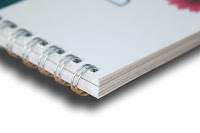http://www.studentbookbinding.co.uk/blog/types-of-binding
Saddle-stitching - It's probably the easiest (have you the tools) and the most economical binding method. Pages are folded, creased and stapled together (not by an ordinary stapler - a stapler with long jaws, designed specifically for saddle stitching). We often see this type of binding used for lookbooks, booklets, and magazines that have a smaller page count.
Perfect Binding - a form of binding most often used in the types of books you find yourself reading on the train or at home, otherwise known as paperback or softcover books. Perfect bound books can also be useful for manuals, catalogues, and annuals. Pages are folded into sections (termed signatures in the industry) and glued with a heavier printed wrap-around cover into the spine using a strong adhesive. It's not the strongest form of binding and your book won't open flat; you'll know a book has been poorly perfect bound when your pages start falling out.
Section Sewn - Your most secure binding method. Here pages are folded together into sections (signatures). Each section is then sewn into the following section along the spine. The spine is then glued together for extra support and the cover attached. A Section Sewn book, regardless of pagecount will be able to lay flat.
Wire Binding/ Spiral Binding - Most of you would have bound a document throughout school or university using one of these methods. In a nutshell, holes are punched through the pages of your document near the bound edge, and held together using either wire or plastic coils. If you're after a something a little fancier, we can wiro bind your document inside a hard cover, cloth or printed case and add some foiling or embossing.
HARDER -
Coptic Binding – A non-adhesive form of binding that stems from bookbinding methods employed by ancient Egyptians! Signatures are sewn through their folds, and attached to one another, and two loose covered boards with a chain like stitch across the spine.
Japanese Binding – This is useful for binding single sheets of paper. You can have either a soft back or hard back cover which attaches to the text block with decorative stitching along the spine. Another option using this decorative sewing technique is to only expose the stitching on the inside of the book, achieved by turning in the edge of the cover boards to create a hinge; the book is then sewn from the inside. We would only recommend binding Japanese style for large or landscape format books as the binding requires a large margin.













No comments:
Post a Comment